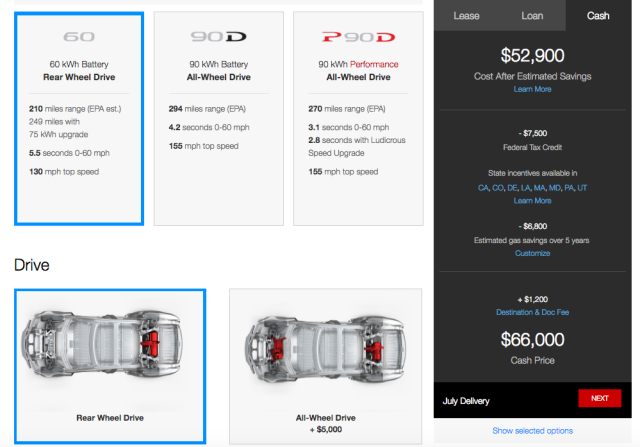
On Thursday, Tesla filled the gap in its range with a new entry-level Model S 60. The car starts at $66,000 before tax incentives. Tesla previously discontinued the Model S 70 due to lack of demand, but this new model is several thousand dollars cheaper. Once rebates and gas savings factor in, the company says "the effective cost of owning Model S 60 comes to about $50k."
The Model S 60 gets a 60kWh battery, good for 0-60mph (0-96km/h) in 5.5 seconds and 200 miles of range between charges. It comes with the full suite of driver assists, and if you decide at some point you want more juice, a software upgrade will unlock the battery to 75kWh.
Tesla's approach to selling electric vehicles has been fascinating. Launching straight into the upper end of the market with the Model S was clever, and it laid the groundwork for the Model 3 mass-market follow-up. With the top and bottom ends covered (reminiscent of Shaka Zulu's "Buffalo Horns" strategy perhaps?), Tesla has moved in for the kill at the middle. This new Model S fits nicely between the $35,000 Model 3 and $89,500 Model S 90D, and the price is aimed squarely at buyers of mid-level luxury cars like the A6, 5 Series, and E-Class.
 Ein Daala-Entwickler berichtet vom Fortschritt des freien Videocodecs, der schon jetzt teilweise besser sein soll als HEVC alias H.265. Einige der in Daala getesteten Neuerungen werden außerdem Teil des neuen Codecs AV1 der Alliance for Open Media. (
Ein Daala-Entwickler berichtet vom Fortschritt des freien Videocodecs, der schon jetzt teilweise besser sein soll als HEVC alias H.265. Einige der in Daala getesteten Neuerungen werden außerdem Teil des neuen Codecs AV1 der Alliance for Open Media. (
 Super Vectoring ist ab nächstem Jahr auf dem Markt, wie Huawei auf der Angacom erklärte. Die Telekom will die Technik einsetzen, mit der Datenraten von 300 MBit/s im Kupfernetz möglich werden. (
Super Vectoring ist ab nächstem Jahr auf dem Markt, wie Huawei auf der Angacom erklärte. Die Telekom will die Technik einsetzen, mit der Datenraten von 300 MBit/s im Kupfernetz möglich werden. (



 Design-Ethiker Tristan Harris ärgert sich darüber, wie unethisch Firmen aus dem Silicon Valley sich verhalten. Sie behandelten Nutzer, als ob diese an einem Glücksspielautomaten säßen. Anstatt deren Alltag zu verbessern, ginge es nur darum, Aufmerksamkeit zu maximieren. (
Design-Ethiker Tristan Harris ärgert sich darüber, wie unethisch Firmen aus dem Silicon Valley sich verhalten. Sie behandelten Nutzer, als ob diese an einem Glücksspielautomaten säßen. Anstatt deren Alltag zu verbessern, ginge es nur darum, Aufmerksamkeit zu maximieren. ( Nach dem Weggang der kompletten Führungsriege zu Oneplus wurde es ruhig um Paranoid Android. Jetzt meldet sich das neue Team mit einem Relaunch zurück: Das neue ROM basiert auf Android 6.0.1 und bietet wieder einige Extrafunktionen, unter anderem den früheren Hover-Modus. (
Nach dem Weggang der kompletten Führungsriege zu Oneplus wurde es ruhig um Paranoid Android. Jetzt meldet sich das neue Team mit einem Relaunch zurück: Das neue ROM basiert auf Android 6.0.1 und bietet wieder einige Extrafunktionen, unter anderem den früheren Hover-Modus. (